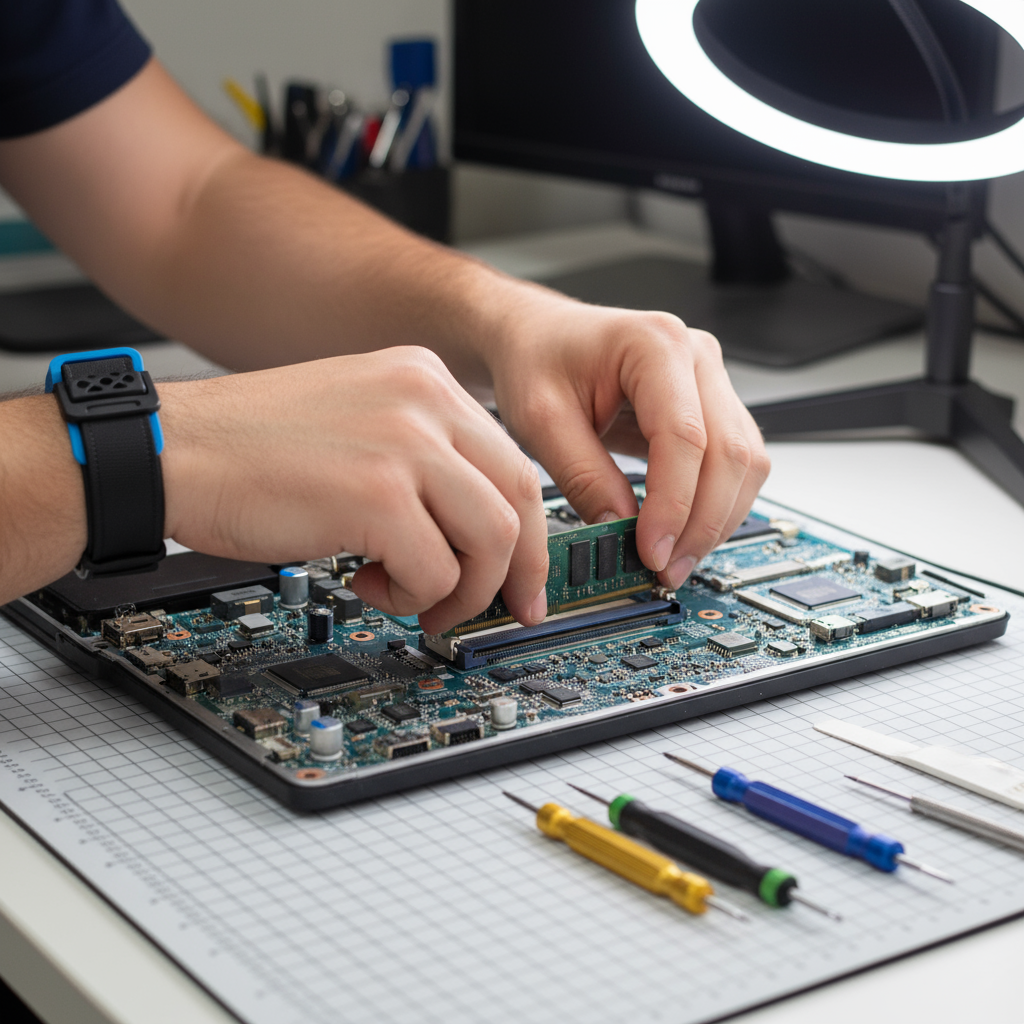
Table of Contents
Introduction
Your laptop’s driving you crazy, isn’t it? That spinning wheel of doom when you try to open Chrome. The way it chokes when you’ve got Spotify, Word, and a few browser tabs running. Sound familiar? Here’s the thing—you’re probably dealing with a memory bottleneck, and there’s a surprisingly simple fix that won’t break the bank.
Upgrading your laptop’s RAM is like giving your computer a shot of espresso. Suddenly, everything just… works better. Whether you’re cramming for finals, juggling spreadsheets at work, or trying to edit that vacation video without wanting to throw your laptop out the window, more memory can transform your experience. And the best part? You don’t need to be a tech genius to pull this off.
Think of RAM (Random Access Memory) as your laptop’s workspace. Right now, it’s probably cluttered and cramped—like trying to cook a five-course meal on a cutting board. When you upgrade, you’re essentially getting a bigger kitchen counter. Your laptop can keep more things within easy reach, which means less waiting around for programs to load and fewer of those frustrating freezes. Speaking of keeping things running smoothly, you might want to check out how to clean charging ports and how to reset Bluetooth headphones—because what’s the point of faster performance if your devices won’t stay connected?
Now, let’s be real for a second. Technology keeps getting hungrier. The apps you’re using today need way more juice than the ones from a few years ago. AI tools, video streaming, gaming, creative software—they’re all memory hogs. That’s why understanding what’s coming in 2025 matters. We’re not slowing down anytime soon. Plus, with everything going digital in classrooms and workplaces, your laptop needs to keep up. The way technology is reshaping education shows just how important it is to have hardware that won’t hold you back.
Here’s what I love about RAM upgrades—they’re one of the few computer modifications that actually make sense for regular people. You don’t need special tools (well, maybe a screwdriver), and you won’t void your warranty in most cases. But (and this is important) you do need to pay attention to what you’re buying. Get the wrong type, and you’ll be staring at expensive paperweights.
What You’ll Learn in This Guide
Ready to dive in? This guide will walk you through everything you need to know, step by step. No confusing jargon, no assumptions that you’ve done this before—just straightforward help to get your laptop running like it should.
- Understanding Laptop RAM: We’ll break down what RAM actually does, decode those confusing terms like DDR4 and SO-DIMM, and help you figure out exactly what your laptop needs—no guesswork required.
- Checking Compatibility Before Upgrading: Learn the detective work: finding your laptop’s memory limits, figuring out what modules will actually work, and using free tools to double-check everything before you spend a dime.
- Preparing to Upgrade Your RAM: The boring but crucial stuff—protecting your laptop (and yourself) from static electricity, backing up your files just in case, and setting up a workspace that won’t drive you nuts.
- Step-by-Step RAM Installation Guide: The main event—opening your laptop without breaking anything, installing the new memory correctly, and putting everything back together so it actually works when you’re done.
By the time we’re finished, you’ll not only have a faster laptop but also the confidence to tackle this kind of upgrade again. Plus, I’ll share some troubleshooting tricks for when things don’t go exactly as planned (because let’s face it, they sometimes don’t).
We’re going to start with the basics and work our way up to the actual installation. Along the way, remember that taking care of your laptop means more than just upgrading its guts. Simple maintenance—like keeping those charging ports clean—can make a huge difference in how well everything works together.
Look, I get it. Opening up your laptop feels scary the first time. But here’s the truth: manufacturers design these things to be serviceable. They want you to be able to upgrade when you need to. This isn’t some dangerous procedure that’ll fry your computer (as long as you follow the steps). It’s a skill that’ll save you money and keep your laptop relevant longer.
So if you’re tired of waiting for your laptop to catch up with your life—if you want to actually enjoy using your computer instead of constantly fighting with it—let’s get started. Time to turn that sluggish machine into something that works with you, not against you.

Want to breathe new life into your sluggish laptop? Upgrading your RAM might be exactly what you need. It’s one of those upgrades that actually makes a difference—better multitasking, snappier performance, and your laptop suddenly feels years younger. Whether you’re just browsing and streaming or pushing your machine with heavy workloads, getting the RAM upgrade right can transform your computing experience. Here’s the thing: with today’s software getting more demanding by the day, that extra memory often provides the boost that makes you wonder why you waited so long.
Understanding Laptop RAM and Compatibility
Before we dive into the upgrade itself, let’s talk about what RAM actually does. Think of RAM (Random Access Memory) as your laptop’s workspace—the bigger the desk, the more projects you can spread out without everything getting cramped. It temporarily holds the data your computer needs right now, which directly impacts how fast things feel and how many apps you can juggle without everything grinding to a halt. Now, here’s where it gets a bit technical (but stick with me): there are different types like DDR3, DDR4, and DDR5, each with their own speed and power characteristics. Your laptop uses a special compact version called SO-DIMM—basically the laptop-sized version of desktop memory sticks. And while we’re talking about keeping your laptop in top shape, you might want to check out how to clean charging ports since maintaining all your components helps everything run better longer.
So how much RAM do you actually need? Good question. If you’re a casual user—web browsing, email, maybe some light photo editing—4 to 8 GB usually does the trick. But if you’re gaming, editing videos, or running multiple demanding programs? You’ll want 16 GB or more. (Trust me, there’s nothing worse than your laptop freezing mid-project because you ran out of memory.) The good news is that figuring out what you need isn’t guesswork. Most laptop manufacturers provide detailed specs, and there are handy software tools that can tell you exactly what RAM you have now and what your laptop can handle. This homework phase might seem boring, but it prevents the frustration of buying the wrong modules.
Key Aspects of Understanding Laptop RAM
Here’s what you need to know to make smart decisions:
- RAM Types and Evolution: DDR3, DDR4, and DDR5 each bring improvements in speed and efficiency. Newer generations mean better performance and longer battery life—but only if your laptop supports them.
- SO-DIMM Form Factor Specifications: Your laptop uses these smaller modules, not the full-size desktop versions. Getting this wrong means a trip back to the store.
- RAM Capacity Needs Assessment: Match your memory to your habits. No point paying for 32 GB if you’re just checking Facebook, but don’t shortchange yourself if you’re running heavy software.
- Compatibility Tools and Software: Use manufacturer resources and diagnostic tools to check your current setup. A few minutes of research saves hours of headaches later.
Once you’ve got the technical stuff sorted, it’s time for the hands-on part—and that’s where preparation becomes your best friend.
Preparing and Installing RAM Safely
Alright, let’s get into the actual upgrade. First things first: preparation isn’t optional here. You’re about to open up your laptop and mess around with delicate electronics, so a little caution goes a long way. Grab the right screwdrivers for your laptop (usually small Phillips head), an anti-static wrist strap if you have one, and find a clean, well-lit workspace. Static electricity is the silent killer of computer components—one wrong zap and your expensive new RAM becomes a paperweight. Even just touching a grounded metal object regularly helps discharge any static buildup. Oh, and here’s something many people forget: back up your important files first. Sure, a RAM upgrade shouldn’t affect your data, but why take chances?
Now for the actual installation. Take your time opening the laptop case—those little screws love to roll away and hide under furniture. (Ask me how I know.) When you locate the RAM slots, you’ll see how the memory modules slide in at an angle before clicking down flat. The key is gentle but firm pressure—don’t force anything. There’s usually a small notch that prevents you from inserting the module backward, so if it’s not going in easily, check your alignment. When it’s properly seated, the little clips on either side should snap into place. Close everything back up, boot your laptop, and check that your system recognizes the new memory. That moment when you see the higher RAM count? Pure satisfaction.
Key Aspects of RAM Preparation and Installation
These steps make the difference between success and frustration:
- Data Backup Importance: Back up your files before opening anything. It’s probably overkill, but better safe than sorry—especially with important documents or photos.
- Static Electricity Precautions: Ground yourself regularly or use an anti-static strap. Those tiny components are surprisingly fragile when it comes to static discharge.
- Proper Handling and Tools: Use the right screwdrivers, keep track of tiny screws, and don’t force anything. Patience prevents expensive mistakes.
- Step-by-Step Installation Method: Follow the angle-then-press-down method for installing modules. When done right, everything clicks into place smoothly—literally.

Here’s the thing about upgrading your laptop’s RAM—it’s like giving your computer a shot of espresso. Suddenly, everything just works better. Your programs launch faster, multitasking becomes smooth as butter, and that sluggish feeling? Gone. But here’s what really matters: you figured out the RAM types (DDR3, DDR4, DDR5) and made sure everything was compatible before diving in. Smart move. That preparation saved you from some expensive headaches.
The installation itself? Pretty straightforward once you know the steps. Sure, it might have felt nerve-wracking the first time—handling those tiny modules, making sure everything clicked into place just right. But you did it. And now you know exactly what to do if your laptop doesn’t immediately recognize the new memory. (It happens sometimes, no big deal.)
So what’s next? Time to put this knowledge to work. Grab your tools, pick out some compatible memory that fits your laptop’s specs, and get started. Just remember the golden rules: back up your data first (trust me on this one), and always discharge that static electricity before touching anything inside your laptop. Those components are tougher than they look, but why take chances?
Now that your laptop is running like a dream, let’s talk about keeping it that way. Your shiny new RAM deserves a clean machine to live in, so check out our guide on how to clean charging ports—because good connectivity matters just as much as good memory. Having trouble with your Bluetooth headphones after all this tinkering? We’ve got you covered with how to reset Bluetooth headphones. And hey, with all that extra performance you just unlocked, why not explore some amazing VR games coming in 2025? Your upgraded laptop can probably handle way more than you think. Want to stay ahead of the curve? Take a peek at the latest technology trends for 2025—it’ll give you some great ideas for your next upgrade project.
Look, upgrading your laptop’s RAM isn’t just about the hardware—it’s about taking control. You just proved you can dive into your machine, understand how it works, and make it better with your own hands. That’s pretty awesome. Keep that momentum going with regular maintenance and stay curious about new tech. Your laptop is going to reward you with years of faster, smoother performance. And honestly? The confidence you just built is worth just as much as the speed boost.
Frequently Asked Questions
-
Can I upgrade RAM on any laptop?
- Most laptops allow RAM upgrades, but some ultrabooks have soldered RAM that cannot be upgraded.
-
How do I know if my laptop supports DDR4 or DDR5 RAM?
- Check your laptop specifications or manufacturer’s website for supported RAM types.
-
Will upgrading RAM improve my laptop speed?
- Upgrading RAM can significantly improve multitasking and performance in memory-intensive tasks.
-
Is professional installation necessary?
- While many can upgrade their RAM, if unsure or uncomfortable, it is best to seek professional help.
-
What if my laptop doesn’t recognize the new RAM?
- Common causes include improperly seated RAM, incompatible modules, or hardware issues; troubleshooting steps should be followed.
